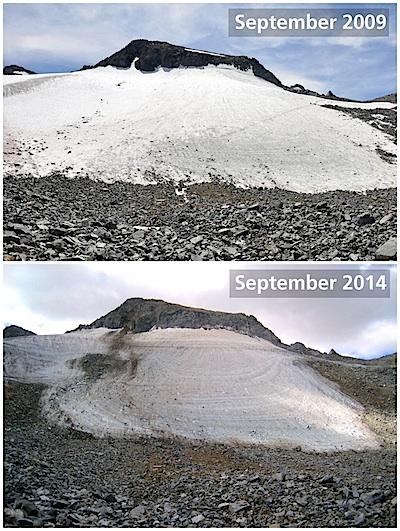
The shrinking Lyell Glacier/NPS photos.
Is it time to start a pool over when the Lyell Glacier in Yosemite National Park is no longer classified as a glacier? Or when it vanishes from the landscape? Those are good questions to ask, as the glacier, the second largest in the Sierra Nevada according to the National Park Service, is continuing to shrink.
The National Park Service's Climate Change Response team says the glacier "has thinned rapidly over just the last few years. Note (in the accompanying photo) the newly exposed bedrock on the east (left) side; it's estimated the glacier may now be only 15-20 feet thick. Currently the glacier is losing on average about three feet of thickness each year. How much longer until it's gone?"
It was back in February 2013 when word came that the Lyell Glacier had stagnated, or ceased its downhill movement, while the adjacent Maclure Glacier was still moving at its historical rate, about one inch per day.



Comments
Has anyone jumped back to the earlier story? Here's a key snippet from that one from last year:
What's going on with the Lyell Glacier apparently did not happen overnight.
Sure beachdump, whatever you say. Maybe it's going to take more than the NPS moving the lighthouse at CHNS from the rising tide to convince you. Although, to anyone with more than two working neurons that would be some compelling evidence showcasing evidence of rising sea levels...
Nor does it correlate with CO2 emissions.
No - because the "record" is a minscule fraction of the earth's history.
And once again you run from the question. If CO2 causes global warming, why has there not been a rise in global temperatures over the last (nearly) two decades despite massive increases in CO2?
Well, perhaps a better way to put it, EC, is that rising CO2 emissions did not drive the melting, for as the glacier has continued to melt the CO2 emissions into the atmopshere have continued to rise.
We'll have a story tomorrow that will delve into this much more deeply that you'll find fascinating.
EC, the evidence is there.
The human primate is pulling stored carbon out of the ground and burning it and displacing it into the atmosphere. That has an accumulative affect. I did not run from the question. I have already shown that 10 of the warmest years on record are all from 1998 and beyond. So there has very much been a rise in global surface temperatures. PROVE THAT THERE HASNT been a rise in global temperatures, when data collected from weather stations from around the planet have proven that it has. PROVE IT EC! You just say it as if it has weight behind it, when you provide no evidence. That's just empty words. Prove it with some weight behind it. Until you do, I just see you as an empty talking head.
So Gary - to get this on record, your claim is that global temperatures have continued to rise over the last two decades?
I don't have to claim it. I just have to look at the data, which I can pull from a variety of sources to see that as fact.